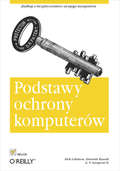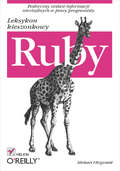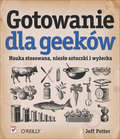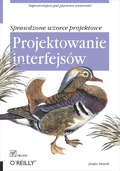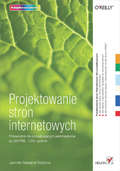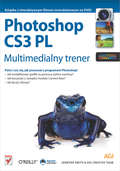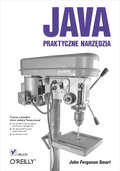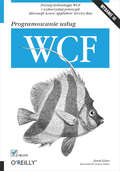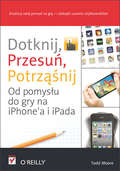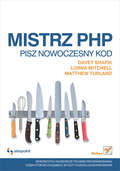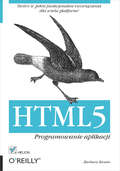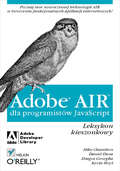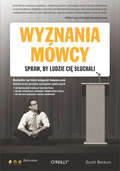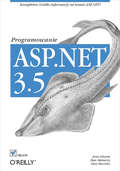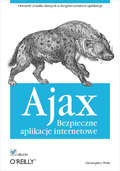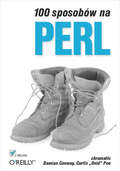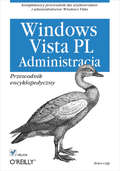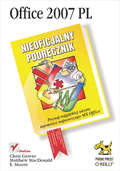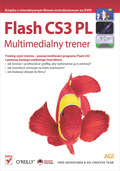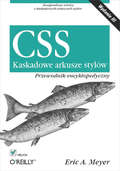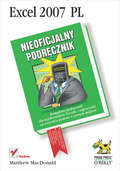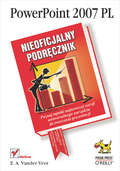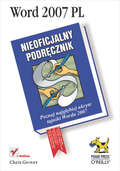- Table View
- List View
80 sposobów na Ajax
by Bruce W. PerryTechniki tworzenia nowoczesnych aplikacji internetowych Przygotowywanie wygodnych w obs?udze formularzy Integracja witryny z Google Maps Zarzšdzanie po?šczeniami sieciowymi Ajax to nazwa technologii powsta?ej w wyniku po?šczenia j?zyka JavaScript, XML oraz kaskadowych arkuszy stylów. Jej wdro?enie pozwala wyeliminowa? ze stron WWW jednš z ich najbardziej irytujšcych cech, czyli konieczno?? prze?adowywania zawarto?ci po ka?dej zmianie. Umiej?tne wykorzystanie mo?liwo?ci Ajaksa sprawia, ?e aplikacje internetowe przypominajš "zwyk?e" programy dla systemów Windows lub Mac OS. Dzi?ki zastosowaniu Ajaksa aplikacja internetowa dzia?a zdecydowanie szybciej, a po?šczenia z serwerem nie przeszkadzajš u?ytkownikowi w pracy. ?atwiejsza jest tak?e dynamiczna zmiana elementów w ró?nych cz??ciach strony. Rozwišzania oparte na Ajaksie wprowadzono w wielu dziedzinach, takich jak blogi, narz?dzia s?u?šce do nauki, newslettery oraz ma?e portale internetowe. W ksiš?ce "80 sposobów na Ajax" znajdziesz przyk?ady zastosowania tej techniki w tworzeniu interesujšcych i nieszablonowych witryn WWW. Czytajšc jš, dowiesz si?, jak sprawi?, aby witryny WWW by?y bardziej interaktywne, a aplikacje WWW dzia?a?y dok?adnie tak jak aplikacje desktopowe. Nauczysz si? korzysta? z interfejsów programistycznych witryn Google Maps, Yahoo! Maps i Geo URL oraz obs?ugiwa? sesje i cookies z poziomu Ajaksa. Poznasz równie? metody weryfikowania poprawno?ci danych wprowadzanych do formularzy oraz techniki ?šczenia Ajaksa z innymi nowoczesnymi narz?dziami, takimi jak Ruby on Rails. Tworzenie interaktywnych formularzy Po?šczenia z Google Maps i Yahoo! Maps Korzystanie z us?ugi Geo URL Obs?uga plików cookies Przeglšdanie kana?ów RSS Integracja z aplikacjami sieciowymi napisanymi w Javie Korzystanie z bibliotek Prototype i Rico Po?šczenie Ajaksa z Ruby on Rails Wykorzystanie biblioteki script.aculo.us do tworzenia efektów wizualnych Twórz szybkie, wydajne i wygodne w obs?udze aplikacje sieciowe.
Podstawy ochrony komputerów
by Rick Lehtinen G. T. Gangemi Sr. Deborah RussellZadbaj o bezpiecze?stwo swojego komputera Poznaj zagro?enia, na jakie nara?ony jest komputer Naucz si? kontrolowa? dost?p do komputera Stosuj techniki zapewniajšce bezpiecze?stwo w sieci Czy mój komputer na pewno jest bezpieczny? Wiele osób zadaje sobie to pytanie dopiero w momencie, kiedy system zaczyna zachowywa? si? w podejrzany sposób. Okazuje si? wówczas, ?e skaner wykrywa dziesištki, a nawet setki wirusów, programy zaczynajš dzia?a? nieprawid?owo, a z dysku ginš wa?ne dane. Pó? biedy, je?li jest to tylko domowy komputer z prywatnymi plikami. Du?o gorsze skutki mo?e mie? w?amanie do firmowej bazy danych lub przechwycenie poufnej komunikacji. Ksiš?ka "Podstawy ochrony komputerów" to wszechstronne wprowadzenie do najwa?niejszych zagadnie? dotyczšcych bezpiecze?stwa danych i sprz?tu. Czytajšc jš, poznasz zagro?enia, jakie czyhajš na u?ytkowników komputerów, ale tak?e skuteczne techniki ochrony. Nauczysz si? kontrolowa? dost?p do danych, prowadzi? efektywnš polityk? zabezpiecze?, wykrywa? i usuwa? wirusy oraz zapobiega? przenikaniu ich do systemu. Dowiesz si?, jak zapewni? bezpiecze?stwo komputera w sieci oraz jak u?ywa? szyfrowania do przesy?ania poufnych informacji. Przeczytasz te? o najnowszych technikach zabezpieczenia bazujšcego na danych biometrycznych (wzorze siatkówki czy odciskach palców) oraz ochronie sieci bezprzewodowych. Niebezpiecze?stwa gro?šce u?ytkownikom komputerów Kontrolowanie dost?pu do komputera Walka z wirusami Prowadzenie skutecznej polityki zabezpiecze? Bezpieczne korzystanie z sieci Szyfrowanie poufnych danych Komunikacja bez ryzyka Zabezpieczenia biometryczne Tworzenie bezpiecznych sieci bezprzewodowych Stosuj skuteczne zabezpieczenia i zapewnij maksymalne bezpiecze?stwo swojemu komputerowi!
Ruby. Leksykon kieszonkowy
by Michael FitzgeraldPodr?czny zestaw informacji niezb?dnych w pracy programisty Ruby to obiektowy j?zyk programowania, opracowany w 1995 roku w Japonii. Dzi?ki swojej prostej sk?adni, zwartej konstrukcji i sporym mo?liwo?ciom b?yskawicznie zyska? ogromne grono zwolenników. Pojawienie si? mechanizmu Ruby on Rails, niesamowicie usprawniajšcego tworzenie aplikacji i witryn internetowych zgodnych z nurtem Web 2.0, dodatkowo zwi?kszy?o popularno?? j?zyka Ruby. W oparciu o ten j?zyk powsta?o wiele znanych serwisów WWW, odwiedzanych ka?dego dnia przez tysišce go?ci. "Ruby. Leksykon kieszonkowy" to zestawienie niezb?dnych informacji o tym j?zyku, przydatne podczas codziennej pracy programisty. Znajdziesz w nim informacje o s?owach kluczowych, operatorach, zmiennych i sta?ych. Przeczytasz tak?e o formatowaniu tekstu, wyra?eniach regularnych, operacjach na plikach i programowaniu obiektowym. Dowiesz si? ponadto, jak korzysta? z interaktywnego Ruby i RDoc. Uruchamianie interpretera Ruby S?owa kluczowe Zmienne Instrukcje warunkowe Programowanie obiektowe Modu?y Operacje na plikach Obs?uga wyjštków Metody klas Array, Hash, Object, Kernel i String Wyszukiwanie i usuwanie b??dów Usprawnij i przyspiesz swojš prac?, korzystajšc z leksykonów kieszonkowych.
Gotowanie dla Geeków. Nauka stosowana, niez?e sztuczki i wy?erka
by Jeff PotterNie samym kodem informatyk ?yje!Cho? trudno to sobie wyobrazi?, w ?yciu ka?dego programisty, administratora, webmastera czy hakera przychodzi w ko?cu taka chwila, kiedy musi wyj?? zza ukochanego monitora… i najzwyczajniej w ?wiecie co? zje??! W ko?cu informatyk te? cz?owiek i nie tylko g?ód wiedzy zaglšda mu w oczy! Niestety nikt nie wymy?li? jeszcze sposobu na to, by ?cišgnš? z sieci aplikacj? z technikami kuchennymi i za?adowa? jš bezpo?rednio do komórek pami?ci. Je?li wi?c b?šd w programie w?šcza w Tobie automatyczny mechanizm rozwišzywania pasjonujšcej zagadki, a w kuchni ko?czy si? powa?nš awariš skutkujšcš zamówieniem pizzy - pora spojrze? na gotowanie jak na nowy, pasjonujšcy algorytm. Wbrew pozorom tutaj tak?e cišg jasno zdefiniowanych czynno?ci daje oczekiwany wynik, a nauka gotowania podobnie jak zg??bianie linijek kodu nierozerwalnie ?šczy si? z dociekliwo?ciš, zadawaniem pyta? i znajdowaniem ?róde? informacji. Chyba co? o tym wiesz, prawda? Trzymasz w r?kach co? wi?cej ni? zwyk?š ksiš?k? kucharskš. Oto pierwsza publikacja dla informatyków, która zamiast zagoni? Ci? do klawiatury, wyp?dzi Ci? zza niej i zainspiruje do smakowitych kulinarnych eksperymentów! Otrzymasz przy tym solidnš porcj? sycšcej umys? i ?o?šdek wiedzy, m.in. na temat niezb?dnych w kuchni narz?dzi, sk?adników, czasu i temperatury gotowania poszczególnych produktów czy fizjologii smaku i zapachu. Autor i pasjonat sztuki kulinarnej, Jeff Potter, udzieli Ci mnóstwa praktycznych wskazówek i zasypie ?wietnymi przepisami o ró?nym stopniu trudno?ci — od tych s?odkich i dziecinnie prostych po niezwykle wyrafinowane. Na kartach ksiš?ki znajdziesz tak?e mnóstwo podsycajšcych Twojš kreatywno?? wywiadów oraz rozmów z naukowcami, technologami ?ywienia, mistrzami kulinarnymi i autorami kuchennych blogów. Wszystko po to, aby szybko i przyjemnie przybli?y? Ci? do realizacji ambitnego zadania, przygotowania smacznego i zdrowego posi?ku!http://blogi.helion.pl/lyceum/gotowanie-dla-geekow">Poznaj przepisy Jeffa Pottera na blogu o gotowaniu! »A oto przedsmak tego, co znajdziesz na kolejnych kartach ksiš?ki:Przygotujesz swojš kuchni? do wielkich wyzwa? i dokonasz kalibracji narz?dzi, którymi dysponujesz.Dowiesz si?, dlaczego niektóre produkty piecze si? w temperaturze 175°C, a inne w 190°C, a tak?e jak szybko przygotowa? pizz?, je?li podkr?cisz piekarnik do 540°C.Poznasz najwa?niejsze reakcje, z jakimi b?dziesz mie? do czynienia podczas gotowania — denaturacj? bia?ek, reakcj? Maillarda, karmelizacj?. I dowiesz si?, jak wp?ywajš one na przyrzšdzane przez Ciebie dania.Poeksperymentujesz i zabawisz si? z potrawami, wykorzystujšc hydrokoloidy i technik? sous vide.Dowiesz si?, co majš do powiedzenia naukowcy, technolodzy ?ywienia, eksperci od no?y, mistrzowie kulinarni, autorzy i inne osoby tworzšce przebogaty ?wiat sztuki kulinarnej, zamieszkiwany przez takich samych zapale?ców, jak pasjonaci komputerów!Apetyt ro?nie w miar? czytania!Ksiš?k? Gotowanie dla geeków http://kuchniaplus.pl/kuchnia_wideo_886_tytul-na-widelcu-3-odc-4.html">poleca Kuchnia +!
Projektowanie interfejsów. Sprawdzone wzorce projektowe
by Jenifer TidwellNajwa?niejsze jest pierwsze wra?enie!Mimo istnienia ogromnej ilo?ci narz?dzi do tworzenia interfejsów u?ytkownika projektowanie dobrych interfejsów aplikacji wci?? nie jest ?atwe. Ta bestsellerowa ksi??ka jest jednym z niewielu wiarygodnych ?róde?, które pomog? Ci przej?? przez istny labirynt wariantów projektowych. "Projektowanie interfejsów" przedstawia najlepsze praktyki i gotowe do wdro?enia pomys?y w postaci wzorców UI oraz dostarcza rozwi?za? powszechnych problemów w dziedzinie projektowania. Rozwi?zania te mo?esz ?atwo dostosowa? do sytuacji, w jakiej si? znajdujesz.W niniejszym zaktualizowanym wydaniu znajdziesz wzorce do wykorzystania zarówno w aplikacjach mobilnych i mediach spo?eczno?ciowych, jak i w aplikacjach internetowych czy programach komputerowych. Ka?dy wzorzec zilustrowany jest przyk?adowymi projektami oraz opatrzony praktycznymi poradami, z których mo?esz natychmiast skorzysta?. Do?wiadczeni projektanci mog? u?ywa? tego przewodnika jako ?ród?a pomys?ów, za? pocz?tkuj?cy mog? go potraktowa? jak map? w drodze przez ?wiat projektowania interfejsów i interakcji.Twórz porywaj?ce i praktyczne interfejsy - pewnie, a nie po omackuPoznaj trudne do interpretacji koncepcje projektowania: afordancje, hierarchi? wizualn?, odleg?o?? nawigacyjn? oraz wykorzystanie kolorówZapoznaj si? z rekomendacjami poszczególnych wzorców UI, a tak?e z wzorcami zast?pczymi i poradami, kiedy pewnych wzorców nie nale?y u?ywa???cz i zestawiaj wzorce interfejsu wed?ug upodoba?Dopie?? wygl?d i dzia?anie interfejsów dzi?ki wykorzystaniu zasad projektowania graficznego oraz wzorcówU?ytkownicy wybieraj? atrakcyjne i praktyczne interfejsy!
Projektowanie stron internetowych. Przewodnik dla pocz?tkuj?cych webmasterów po (X)HTML, CSS i grafice
by Jennifer Niederst RobbinsJak zacz?? pisa? strony internetowe?Jak wybra? odpowiednie narz?dzia do tworzenia witryn?Jak budowa? arkusze stylów i optymalizowa? ?ród?o strony HTML?Od czego mam zacz??? Czy ja si? do tego nadaj?? Nie mam na to czasu...Wielu z nas w?a?nie z takim nastawianiem zabiera si? do pisania swojej pierwszej strony internetowej. Takie i podobne w?tpliwo?ci rozwiewa w?a?nie ta ksi??ka, przeznaczona dla osób niemaj?cych ?adnej wiedzy na temat tworzenia stron internetowych, a które chcia?yby tak? stron? wykreowa?.Czytaj?c j? i pracuj?c nad wieloma przyk?adami, nauczysz si?, jak opracowa? swoj? pierwsz? stron? internetow? i stopniowo odkryjesz w sobie pasj? webmastera!Jennifer Niederst Robbina, bazuj?c na swoim kilkunastoletnim do?wiadczeniu w dziedzinie tworzenia stron internetowych, udowadnia, ?e pisa? strony mo?e ka?dy, nale?y mu tylko wskaza? drog?.Ksi??ka "Projektowanie stron internetowych" jest trzeci? edycj? przewodnika dla pocz?tkuj?cych, lecz napisana zosta?a ca?kowicie od pocz?tku, z uwzgl?dnieniem najnowszych technologii i trendów w tej dziedzinie.Dodatkowym atutem ksi??ki jest przejrzysto?? i ?atwo przyswajalny j?zyk oraz liczne przyk?ady i ?wiczenia, które pozwalaj? lepiej zrozumie? i przyswoi? materia?. Struktura i znaczniki HTMLElementy struktury (X)HTML Tabele, obrazki, odno?niki, animacje i inne elementy stronFormatowanie tekstu Formularze i pola edycjiP?ywanie oraz pozycjonowanie elementów stronArkusze stylów CSSUk?ad strony oparty na arkuszach stylów CSS Techniki CSSGrafika stron internetowych i jej optymalizacjaUmieszczanie stron w InterneciePoznaj techniki tworzenia, napisz i umie?? w?asn? stron? internetow? w sieci!
Photoshop CS3 PL. Multimedialny trener
by Jennifer Smith Agi Creative TeamPoznaj mo?liwo?ci Photoshopa, aby Twoje obrazy przemawia?y do wyobra?ni Jak modyfikowa? grafiki za pomocš stylów warstwy?Jak ?šczy? obrazy?Jak korzysta? z narz?dzi modu?u Camera Raw?Photoshop CS3 od wielu ju? lat jest doskona?ym i sprawdzonym narz?dziem do profesjonalnego przetwarzania obrazów. Program umo?liwia nie tylko technicznš obróbk? zdj?? i grafiki, które wykorzystywane sš we wszelkiego rodzaju publikacjach, ale tak?e pozwala na realizacj? w?asnych twórczych projektów. W wersji CS3 dodano wiele nowych funkcji (np. filtry inteligentne, zwi?kszenie obszaru roboczego czy ulepszone narz?dzia do zaznaczania), które przede wszystkim umo?liwiajš niedost?pne dotychczas sposoby obróbki, a jednocze?nie u?atwiajš u?ytkowanie. "Photoshop CS3 PL. Multimedialny trener" to Twój osobisty instruktor do nauki Photoshopa, który wprowadzi Ci? krok po kroku -- w tempie, które sam sobie narzucisz -- w kolejne tajniki tego programu, co umo?liwi pos?ugiwanie si? nim na poziomie profesjonalnym. Wykonujšc poszczególne ?wiczenia, nauczysz si? komponowa? obraz przy u?yciu obiektów inteligentnych, modyfikowa? jego barwy za pomocš warstw korekcyjnych, tworzy? obrazy do druku oraz animacje na potrzeby internetu i wideo. Krótko mówišc, dzi?ki tej ksiš?ce staniesz si? zawodowcem. Dokowanie paletStosowanie filtrów inteligentnychWykorzystanie maski warstwyModyfikowanie grafiki za pomocš stylów warstwyKorzystanie z programu Adobe Bridge ?šczenie i poprawianie obrazówZapisywanie pliku w formacie DNGMalowanie i retuszowanieObiekty inteligentne FiltryTworzenie animacji"Photoshop CS3 PL. Multimedialny trener" -- Twój osobisty instruktor, który nauczy Ci? tworzy? lepiej i szybciej, a tak?e wykorzystywa? maksimum mo?liwo?ci aplikacji i Twojej kreatywno?ci!
Java. Praktyczne narzędzia
by John Ferguson SmartPoznaj narzędzia, które okażą się niezbędne! Jak zapewnić wysoką jakość tworzonego rozwiązania?Jak wprowadzić proces ciągłej integracji?Jak testować kod? Możliwości języka Java znają już chyba wszyscy. Dlatego warto jedynie wspomnieć o tym, że oprócz podstawowych narzędzi do tworzenia oprogramowania w tym języku, które zna każdy programista, istnieje wiele innych -- przydatnych i użytecznych -- aplikacji. Potrafią one w niezwykle skuteczny sposób przyśpieszyć oraz ułatwić programowanie w języku Java i sprawić, że będzie to zajęcie jeszcze przyjemniejsze. W żadnej innej książce nie znajdziesz tak szczegółowego omówienia tych narzędzi. Zatem jeśli wykorzystujesz język Java na co dzień, musisz ją mieć! Dzięki tej książce poznasz 33 praktyczne narzędzia, które ułatwią Twoją pracę -- narzędzia, które zwiększą niezawodność Twojego kodu, poprawią wydajność oraz zapewnią bezpieczeństwo Twoim plikom źródłowym. Autor książki omawia kilka grup narzędzi, a wśród nich aplikacje takie, jak Maven, Subversion, JUnit czy też Hudson. Dzięki książce "Java. Praktyczne narzędzia" dowiesz się, jak bardzo na jakość Twojego rozwiązania może wpłynąć proces ciągłej integracji oraz jak ważne są testy jednostkowe czy integracyjne. Ponadto autor książki omawia 29 innych narzędzi, które zwiększają komfort pracy. Otwórz spis treści i spójrz, jak cenne informacje są zawarte w tej książce! Wykorzystanie narzędzi kompilujących (Ant, Maven2)Zastosowanie systemów kontroli wersji (CVS, Subversion)Sposoby oceny jakości kodu (CheckStyle, PMD, FindBugs, Jupiter)Tworzenie wysokiej jakości dokumentacjiPrzygotowanie testów jednostkowych (JUnit, TestNG)Przeprowadzanie testów integracyjnychSystemy raportowania i śledzenia błędów (Bugzilla, Trac)Narzędzia pozwalające na wprowadzenie procesu ciągłej integracji (Continuum, Hudson)Sposoby przeprowadzania testów obciążeniowychProfilowanie i monitorowanie aplikacji za pomocą narzędzi dostępnych w pakiecie JDK oraz Eclipse Zobacz, jak łatwo można wykonać skomplikowane zadania!
Programowanie us?ug WCF
by Juval LöwyPoznaj technologi? WCF i wykorzystaj potencja? Microsoft Azure AppFabric Service BusUdost?pnianie us?ug sieciowych to ju? nie tylko widzimisi? programistów lub projektantów - w dzisiejszych czasach to obowi?zek! Dzi?ki temu u?atwiasz integracj? innych aplikacji z Twoim produktem, ale te? z ?atwo?ci? korzystasz z funkcjonalno?ci dostarczanych przez innych producentów. Najwa?niejsze jest jednak to, ?e najwi?cej zyskuje Twój klient. A jego zadowolenie zapewni Ci sukces i byt na rynku!Je?eli podj??e? decyzj?, ?e Twoja kolejna aplikacja b?dzie wspiera?a WCF, to wybieraj?c t? ksi??k?, nie mog?e? trafi? lepiej. "Programowanie us?ug WCF" to doskona?y, ciesz?cy si? ogromn? popularno?ci? przewodnik, po?wi?cony spójnej, jednolitej platformie firmy Microsoft, któr? zaprojektowano z my?l? o programowaniu aplikacji w oparciu o us?ugi dla systemu Windows. Jej autor Juval Löwy jest wybitnym specjalist? w dziedzinie platformy .NET i technologii WCF. W trakcie lektury poznasz architektur? technologii WCF, jej elementy sk?adowe oraz zagadnienia zwi?zane z jej niezawodno?ci?. Ponadto dowiesz si?, jak zagwarantowa? bezpiecze?stwo swoim us?ugom sieciowym, oraz sprawdzisz mo?liwo?ci magistrali us?ug Azure AppFabric Service Bus. Wiedza, któr? zdob?dziesz, pozwoli Ci na tworzenie jeszcze lepszych i bardziej elastycznych projektów informatycznych. Sprawd? sam!Poznaj architektur? technologii WCF i jej podstawowe elementy sk?adowe, w tym tak wa?ne poj?cia, jak niezawodno?? czy sesja transportowaNaucz si? u?ywa? wbudowanych elementów, takich jak hosty us?ug, mechanizmy zarz?dzania instancjami i wspó?bie?no?ci?, transakcje, kolejkowane wywo?ania roz??czonych us?ug, zabezpieczenia czy odkrywanieOpanuj sztuk? korzystania z magistrali us?ug Azure AppFabric Service Bus, czyli najbardziej rewolucyjnego elementu nowego projektu chmury obliczeniowejPodnie? swoj? produktywno?? i jako?? tworzonych us?ug WCF dzi?ki odpowiednim opcjom projektowym, wskazówkom i zalecanym praktykom, zawartym we frameworku ServiceModelEx autorstwa Juvala Löwy’egoPoznaj uzasadnienie szczegó?owych decyzji projektowych i odkryj najtrudniejsze, rozumiane przez niewielu programistów aspekty programowania us?ug WCFNajlepszy podr?cznik po?wi?cony WCF!
Dotknij, przesu?, potrz??nij. Od pomys?u do gry na iPhone'a i iPada
by Todd MooreZrealizuj swój pomys? na gr? i odnie? sukces!Nawet je?li rynek gier i aplikacji mobilnych nie prze?cignš? jeszcze rynku tych produktów dla komputerów osobistych, to wkrótce to zrobi. Miliony u?ytkowników, przyst?pne ceny oraz powszechny dost?p do ekranów dotykowych, GPS i internetu — wszystko to sprawia, ?e gry na iPhone’a czy iPada sš cz?sto o wiele bardziej atrakcyjne ni? ich odpowiedniki przeznaczone na zwyk?e komputery. Najwa?niejszy jest pomys? na gr?. Musi by? nowatorski, atrakcyjny i wcišgajšcy. Je?li ju? go masz, ten przewodnik poka?e Ci, w jaki sposób przej?? do utworzenia prawdziwej i-aplikacji. Przedstawiony proces konstruowania rzeczywistej gry pozwoli Ci zdoby? podstawy dotyczšce narz?dzia Xcode i j?zyka Objective-C. Jednocze?nie nauczysz si?, jak implementowa? logik? gry, przygotowywa? grafik? i efekty d?wi?kowe, a tak?e opracowa? sztucznš inteligencj? dla gracza-komputera. Ju? wkrótce mo?esz zdoby? s?aw? i czerpa? z tego wymierne korzy?ci! Z tš ksiš?kš w r?ku ka?dy programista zamieni pomys? na rzeczywisty produkt, gotowy do rozpowszechniania w sklepie iTunes App Store.Zacznij od prostej gry, wymagajšcej utworzenia jedynie oko?o dwudziestu wierszy koduZbuduj ca?kowicie od poczštku gr? w hokeja na stolePoznaj najlepsze praktyki w zakresie ?ledzenia wielu dotyków na ekranieStwórz animacj? i przygotuj funkcje wykrywania kolizjiWykorzystaj niezb?dne narz?dzia do przygotowania atrakcyjnej grafiki dla gryDopracuj fizyk? w grze, aby nada? jej wi?kszy realizmNagraj i przeprowad? edycj? efektów d?wi?kowych oraz utwórz w?asnš muzyk? odtwarzanš w tleZaprojektuj gracza-komputer, grajšcego na ró?nych poziomach trudno?ciZamie? pomys? na produkt gotowy do rozpowszechniania w sklepie iTunes App Store!Todd Moore za?o?y? firm? TMSOFT, by konstruowa? wyjštkowe aplikacje i gry przeznaczone dla smartfonów. Stworzona przez niego popularna gra Card Counter zosta?a wyró?niona przez Engadget, "Los Angeles Times" oraz CNET TV. Najpopularniejsza aplikacja Todda — White Noise — zdoby?a uznanie iTunes App Store, "Health Magazine", "Washington Post", "PC Magazine" i Late Night with Jimmy Fallon.
Mistrz PHP. Pisz nowoczesny kod
by Davey Shafik Lorna Mitchell Matthew TurlandWykorzystaj najnowsze techniki programowania, dzi?ki którym osi?gniesz wy?szy poziom zaawansowania"Mistrz PHP. Pisz nowoczesny kod" to ksi??ka przeznaczona dla programistów PHP, którzy znaj? ju? podstawy tego j?zyka i chc? rozwin?? swoje umiej?tno?ci, by tworzy? bardziej zaawansowane rozwi?zania. Znajdziesz w niej cenne rady, jak udoskonali? swoje aplikacje serwerowe, oraz wszystko, czego potrzeba do stosowania najefektywniejszych technik obiektowych, zabezpieczania kodu czy pisania programów idealnie spe?niaj?cych swoje zadania. W ka?dym rozdziale poznasz nowe sposoby wykonywania pewnych zada? oraz nowe teorie, le??ce u pod?o?a stosowanych przez Ciebie technik. Dzi?ki lekturze tej publikacji przemienisz si? ze sprawnego programisty w pewnego siebie in?yniera - stosuj?cego najlepsze praktyki programistyczne, pracuj?cego szybko i solidnie. Autorzy przedstawiaj? praktyczne problemy i u?yteczne rozwi?zania, które zaprowadz? Ci? na szczyt kariery! Je?li szukasz mo?liwo?ci scementowania ca?ej swojej wiedzy i chcesz zdoby? solidne podstawy, ta ksi??ka jest dla Ciebie.Dowiesz si? z niej, jak:tworzy? profesjonalne dynamiczne aplikacje w oparciu o obiektowe wzorce programowaniau?ywa? zaawansowanych narz?dzi do oceny wydajno?ci programów, aby zmaksymalizowa? ich mo?liwo?cistosowa? nowoczesne techniki testowania, pozwalaj?ce uzyska? niezawodny kodzabezpiecza? programy przed atakami zewn?trznymi przy u?yciu najskuteczniejszych techniku?ywa? funkcji dost?pnych w bibliotekach i interfejsach programistycznych j?zyka PHP…i wiele wi?cejPraktyczne problemy i u?yteczne rozwi?zania, które zaprowadz? Ci? na szczyt kariery!
HTML5. Programowanie aplikacji
by Zachary KessinW sieci trwa w?a?nie rewolucja! Do w?adzy dochodzi j?zyk HTML5!Jego potencja? jest nieograniczony - ?cis?a integracja z przeglšdarkš internetowš, wydajna obs?uga grafiki czy wsparcie dla geolokalizacji to tylko niektóre z jego atutów. Korzystajšc z jego mo?liwo?ci, mo?esz stworzy? ?wietnš gr? lub przydatnš aplikacj? internetowš. Poznaj pe?ne mo?liwo?ci j?zyka HTML5 i dowiedz si?, jak budowa? kompletne i autonomiczne aplikacje, dzia?ajšce na urzšdzeniach przeno?nych i konkurujšce z tradycyjnymi aplikacjami. Dzi?ki temu praktycznemu przewodnikowi odkryjesz skuteczne metody pracy z j?zykiem HTML5, takie jak lokalne magazynowanie danych i przetwarzanie wielowštkowe. Zaznajomisz si? równie? z zaawansowanymi narz?dziami JavaScriptu, które u?atwiajš korzystanie z ca?ej gamy elementów j?zyka HTML5. Je?li jeste? do?wiadczonym programistš JavaScriptu, umieszczone w ksiš?ce przyk?adowe kody poka?š Ci, jak j?zyk HTML5 zamienia sie? WWW w pierwszorz?dne ?rodowisko programistyczne.Zobacz, jak:testowa? aplikacje internetowekorzysta? z bazy IndexedDBpracowa? w trybie offlinewykorzysta? gniazda WWWDo?šcz do zaawansowanych u?ytkowników HTML5!
Adobe AIR dla programistów JavaScript. Leksykon kieszonkowy
by Mike Chambers Daniel Dura Kevin Hoyt Dragos GeorgitaPoznaj moc nowoczesnej technologii AIR w tworzeniu funkcjonalnych aplikacji internetowych! Jak skonfigurowa? ?rodowisko programistyczne w AIR?Jak zaimplementowa? funkcje?Jak utworzy? aplikacj? AIR, wykorzystujšc HTML i JavaScript?Adobe AIR to nowe mi?dzyplatformowe ?rodowisko wykonawcze, które pozwala programistom na wykorzystanie znanych technologii, takich jak HTML i JavaScript, do tworzenia rozbudowanych aplikacji internetowych. AIR oferuje bogaty zbiór wywo?a? API, a tak?e ?cis?š integracj? z pulpitem, co umo?liwia ?šczenie pot?gi zasobów lokalnych z dost?pem do internetu. O atrakcyjno?ci Adobe AIR ?wiadczš wi?c zarówno zasi?g i ?atwo?? programowania (najlepsze cechy modelu WWW), jak i funkcjonalno?? oraz bogactwo modelu pulpitowego.Ksiš?ka "Adobe AIR dla programistów JavaScript. Leksykon kieszonkowy" stanowi wprowadzenie do tworzenia aplikacji Adobe AIR z wykorzystaniem j?zyków HTML i JavaScript. Leksykon zawiera przeglšd mechanizmów wykonawczych HTML i JavaScript w Adobe AIR oraz wyja?nia, jak uzyska? dost?p do funkcji i interfejsów Adobe AIR z poziomu JavaScript. Znajdziesz tu wszelkie porady i wskazówki niezb?dne do tego, by skonfigurowa? ?rodowisko programistyczne, stworzy?, przetestowa? i wdro?y? atrakcyjnš oraz funkcjonalnš aplikacj? WWW.
Wyznania mówcy. Spraw, by ludzie Ci? s?uchali
by Scott BerkunSztuka bycia gwiazd? wyst?pie? publicznych Jak hipnotyzowa? s?uchaczy i porywa? t?umyJak by? rozlu?nionym, zabawnym i kompetentnym mówc?Jak stosowa? podr?czne sztuczki zawodowcówScott Berkun prezentuje przyst?pny i praktyczny poradnik, pozwalaj?cy roz?o?y? sztuk? przemawiania na czynniki pierwsze i dog??bnie j? zrozumie?. Szerokie do?wiadczenie autora u?atwia zrozumienie l?ku przed wyst?powaniem publicznym, gdy? wi?kszo?? tego, czego si? obawiamy, istnieje wy??cznie w naszym umy?leMichael Lopp, autor ksi??ki Managing HumansCyceron powiedzia?, ?e nale?y sprawi?, aby s?uchacze byli uwa?ni, otwarci oraz ufni. Jak to osi?gn??? Po pierwsze nale?y unika? pretensjonalnych nawi?za? do martwych ludzi. Po drugie nale?y przeczyta? przydatny i zabawny poradnik przemawiania, napisany przez Scotta BerkunaJay Heinrichs, autor ksi??ki Thank You for ArguingSpó?niasz si? na w?asn? prelekcj?, laptop zaczyna podejrzanie dymi?, na sali jest dziesi?? osób, spo?ród których po?owa przysypia, a reszta ?mieje si? szyderczo, stres parali?uje Ci struny g?osowe, a na dodatek gdzie? w okolicy podst?pnie czai si? szef, czekaj?c na Twoj? wpadk?. A jednak mimo to przeprowadzasz znakomit? i profesjonaln? prezentacj?, a zebrani skanduj? Twoje imi?, prosz?c o wi?cej. Przesada? Mo?e tylko odrobin?.Autor tego hipnotycznego poradnika doskonale zna si? na rzeczy — w trakcie swojej kariery wyg?osi? setki wyk?adów i prze?y? wi?kszo?? nieprzyjemnych, tragicznych czy kr?puj?cych sytuacji, które na ogó? przera?aj? przysz?ych i niedosz?ych mówców. Praktyczne lekcje i zaskakuj?ce wyznania pozwol? Ci popatrze? z zupe?nie innej perspektywy na sztuk? przemówie? publicznych, perswazji, skutecznej komunikacji, uczenia si? oraz nauczania. Chcesz si? uczy?? Ucz si? od mistrza.Dowiedz si?, jak nie zanudzi? s?uchaczy na ?mier?.Odkryj, co robi?, kiedy sprawy id? nie po Twojej my?li.Sprawd?, jak nauczy? innych czegokolwiek.Poznaj sztuk? odpowiadania na niewygodne pytania.Naucz si? pokonywa? l?k i parali?uj?cy strach.Oce?, czego mo?esz nauczy? si?, ?ledz?c wyst?py komików."Przeczyta?am pierwsz? stron?, wy??czy?am telefon i komputer, bo wiedzia?am, ?e nie ma si? co rozprasza?, ta ksi??ka to naprawd? CO?!" -- http://onepress.pl/recenzjamiwypu.phtml">tak o ksi??ce Scotta Berkuna pisze polska bestsellerowa autorka>>
ASP.NET 3.5. Programowanie
by Jesse Liberty Dan Hurwitz Dan MaharryKompletne ?ród?o informacji na temat ASP.NET! Jak maksymalnie wykorzysta? mo?liwo?ci Visual Studio?Jakie tajemnice kryje j?zyk LINQ?Jak tworzy? bezpieczne aplikacje internetowe?Aplikacje internetowe ciesz? si? wci?? rosn?c? popularno?ci?. Na rynku narz?dzi do ich tworzenia mo?na znale?? wiele rozwi?za?, a w?ród nich jedno wyj?tkowe — platform? .NET. Pozwala ona na wykorzystanie dowolnego obs?ugiwanego przez ni? j?zyka programowania do tworzenia dynamicznych, interaktywnych i atrakcyjnych rozwi?za? internetowych. Wybieraj?c platform? .NET, otrzymasz dost?p do wielu dodatkowych narz?dzi i — co najwa?niejsze — do wiedzy zgromadzonej przez ca?? u?ywaj?c? jej spo?eczno??. Niezliczona liczba stron, artyku?ów i osób ch?tnych do pomocy sprawia, ?e rozwi?zanie nawet najbardziej skomplikowanego problemu staje si? ?atwiejsze.Dzi?ki tej ksi??ce zdob?dziesz wiedz? pozwalaj?c? Ci na swobodne poruszanie si? w ?wiecie aplikacji internetowych opartych o .NET. Nauczysz si? w maksymalny sposób wykorzystywa? mo?liwo?ci ?rodowiska Visual Studio 2008, poznasz dost?pne kontrolki oraz sprawdzisz, do czego mo?e Ci si? przyda? ADO.NET. Ponadto odkryjesz tajemnice j?zyka LINQ i zasady, których przestrzeganie zapewni bezpiecze?stwo Twojej aplikacji. W kolejnych rozdzia?ach autorzy przedstawi? Ci metody tworzenia us?ug sieciowych, zwi?kszania wydajno?ci poprzez buforowanie oraz konfiguracji serwera IIS 7.0. Ksi??ka ta pozwoli Ci w ?atwy sposób wykona? pierwszy krok w ?wiat dynamicznych stron WWW, tworzonych z wykorzystaniem ASP.NET.Praca w zintegrowanym ?rodowisku programistycznym Visual Studio 2008Podstawowe kontrolki oraz kontrolki pozwalaj?ce na dost?p do danychDost?p do baz danych z wykorzystaniem ADO.NETZastosowanie j?zyka LINQGwarancja poprawno?ci danychZapewnienie bezpiecze?stwa aplikacji internetowejTworzenie stron wzorcowychPrzygotowanie us?ug sieciowychProtoko?y i standardy us?ug sieciowychPoprawa wydajno?ci poprzez zastosowanie buforowaniaKonfiguracja serwera IIS 7.0 Debugowanie kodu i ?ledzenie jego wykonaniaWdra?anie aplikacji w ?rodowisku lokalnym i globalnymPrzydatne skróty klawiaturowe Poznaj mo?liwo?ci jednej z najpopularniejszych platform do tworzenia dynamicznych stron WWW!
Ajax. Bezpieczne aplikacje internetowe
by Christopher WellsOtwarte ?ród?a danych a bezpiecze?stwo aplikacji Jak zabezpieczy? przep?yw danych klient-serwer? Jak strzec serwera aplikacji przed atakami? Jak przewidzie? i przeciwdzia?a? potencjalnym zagro?eniom w dynamicznych aplikacjach? Otwarto?? i bezpiecze?stwo, utopijne po?šczenie s?ów, a zarazem nieodwracalna przysz?o?? sieci internetowej. Wspó?dzielenie zasobów niesie ze sobš szereg zagro?e? na ró?nych warstwach sieciowych. Efektywniej jest przewidzie? potencjalne zagro?enia na etapie tworzenia aplikacji i zapobiec im, ni? pó?niej ?ata? dziury w oprogramowaniu. Ka?dy programista tworzšcy oprogramowanie sieciowe ostatecznie b?dzie musia? zmierzy? si? z niepo?šdanš ingerencjš majšcš swoje ?ród?o w sieci internetowej. Bšd? na to przygotowany i nie daj si? zaskoczy?, wykorzystaj wiedz? zawartš w tej ksiš?ce. Ksiš?ka "Ajax. Bezpieczne aplikacje internetowe" traktuje o zagro?eniach i sposobach zabezpiecze? aplikacji sieciowych, a szczególnie dynamicznych interfejsów API. Przeznaczona jest zarówno dla programistów zaczynajšcych przygod? z Ajaksem, jak i dla tych, którzy Ajaksa jeszcze nie znajš. Przyda si? ka?demu, kto stoi na stra?y bezpiecze?stwa aplikacji sieciowych, uczy bowiem, jak zapobiega? zagro?eniom w trakcie pisania aplikacji oraz jak przeciwdzia?a? im w ju? istniejšcym oprogramowaniu sieciowym. Bezpiecze?stwo aplikacji sieciowych Technologie zabezpiecze? komunikacji klient-serwer Zabezpieczenia na poziomie protoko?ów Serwer WWW i zagro?enia p?ynšce z internetu Zabezpieczanie otwartych zasobów danych Bezpiecze?stwo interfejsów API Zagro?enia bezpiecze?stwa w aplikacjach typu mushup Twórz rozleg?e aplikacje sieciowe i zadbaj o ich bezpiecze?stwo?
100 sposobów na Perl
by Damian Conway Curtis Ovid" PoeZbiór skutecznych rozwišza? dla programistów aplikacji internetowych Zwi?kszanie produktywno?ci pracy Tworzenie interfejsów u?ytkownika Wyszukiwanie i usuwanie b??dów Perl, od swojego zaistnienia na rynku, wyewoluowa? od prostego narz?dzia do przetwarzania tekstów i budowania raportów do formy zaawansowanego j?zyka programowania pozwalajšcego na tworzenie praktycznie ka?dej aplikacji dzia?ajšcej w sieci. Mimo do?? zaawansowanego "wieku", nie traci nic na popularno?ci. W sieci pojawiajš si? coraz nowsze wersje, a grono programistów korzystajšcych z Perla stale ro?nie. Spo?eczno?? u?ytkowników tego j?zyka skupiona wokó? portalu CPAN udost?pnia napisane przez siebie skrypty, wskutek czego z wieloma problemami programistycznymi mo?na sobie poradzi?, korzystajšc z gotowych rozwišza? lub si?gajšc do innych ?róde?. Dzi?ki ksiš?ce "100 sposobów na Perl" odkryjesz ma?o znane i mniej typowe zastosowania tego j?zyka. Czytajšc jš, dowiesz si?, w jaki sposób wykorzysta? Perl do ró?nych zada?. Nauczysz si? zwi?ksza? efektywno?? swojej pracy, tworzy? elementy interaktywne i przetwarza? pliki tekstowe w nietypowy sposób. Zapoznasz si? z odczytywaniem danych z baz i arkuszy kalkulacyjnych, pracš z modu?ami oraz programowaniem obiektowym. Znajdziesz tu tak?e informacje o testowaniu kodu, usuwaniu b??dów i optymalizowaniu wydajno?ci programów napisanych w Perlu. Korzystanie z biblioteki CPAN Automatyczne formatowanie kodu w edytorze Emacs Generowanie elementów graficznych Przetwarzanie arkuszy kalkulacyjnych Praca z bazami danych Tworzenie zestawu narz?dziowego modu?ów Korzystanie z obiektów Testowanie kodu ?ledzenie wykonywania programu
Windows Vista PL. Administracja. Przewodnik encyklopedyczny
by Brian CulpKompleksowy przewodnik dla u?ytkowników i administratorów Windows Vista Jak prawid?owo zainstalowa? Vist??Jak jš optymalnie skonfigurowa??Jak korzysta? z wiersza polece??System Windows Vista od swojego pojawienia si? na rynku zdoby? ju? spore grono zwolenników. Najnowsza wersja najpopularniejszego systemu operacyjnego da?a u?ytkownikom nie tylko efektowny interfejs graficzny, ale przede wszystkim mnóstwo nowych mo?liwo?ci. Nadal jednak wiele z nich pozostaje nieodkrytych lub nie w pe?ni wykorzystanych. Niewiele te? osób wie, w jaki sposób optymalnie skonfigurowa? ten system i administrowa? nim, szczególnie w przypadku wykorzystywania go w grupie roboczej. Poznanie wszystkich aspektów zarzšdzania Vistš jest tak?e niezb?dne dla administratorów sieci.Ksiš?ka "Windows Vista PL. Administracja. Przewodnik encyklopedyczny" to zestawienie najistotniejszych informacji koniecznych do sprawnego administrowania systemem Windows Vista i sieciš kontrolowanš przez ten system. Czytajšc jš, poznasz mo?liwo?ci i funkcje Visty, podobie?stwa i ró?nice pomi?dzy jej wersjami oraz metody personalizacji. Dowiesz si?, jak zainstalowa? system, zoptymalizowa? jego dzia?anie oraz stworzy? profile u?ytkowników. Nauczysz si? zabezpiecza? Vist?, definiowa? prawa u?ytkowników i grup, ustala? udzia?y dyskowe i zasady konta. Przeczytasz tak?e o rozwišzywaniu problemów z dzia?aniem systemu, tworzeniu kopii zapasowych, o pracy z wierszem polece? systemu Windows Vista i wspó?pracy z przeglšdarkš Internet Explorer 7.Nowo?ci w systemie Windows VistaPrzeglšd wersji VistyKonfigurowanie parametrów pracy w sieciTworzenie kont u?ytkownikówPersonalizacja systemu i konfigurowanie u?atwie? dla osób niepe?nosprawnychUruchamianie systemu i praca w trybie awaryjnymKonfigurowanie parametrów sprz?towychZarzšdzanie drukarkamiInstalowanie nowego oprogramowaniaWdra?anie Windows VistyOptymalizacja wydajno?ci systemuZabezpieczanie ?rodowiska VistyDobór parametrów pracy grupowejRozwišzywanie problemów z systememZosta? prawdziwym ekspertem w zakresie administracji systemem Windows Vista!
Office 2007 PL. Nieoficjalny podr?cznik
by Chris Grover Matthew MacDonald E. MoorePoznaj najg??biej ukryte tajemnice najnowszego MS Office Wykorzystaj nieznane mo?liwo?ci Worda, Excela, Accessa i PowerPointa Ujarzmij nowe interfejsy u?ytkownika aplikacji Odkryj najg??biej ukryte narz?dzia Najnowsza wersja pakietu Microsoft Office, oznaczona numerem 2007, to prze?om. Office 2007 nie jest kopiš poprzedniej edycji, do której dodano kilka nowych polece?. To ca?kowicie nowe narz?dzie, posiadajšce przeprojektowany interfejs u?ytkownika, operujšce na plikach w nowym formacie, oferujšce nowatorskie mo?liwo?ci, innš filozofi? pracy i zdecydowanie wy?szy komfort eksploatacji. Jednak przesiadka na nowš wersj? pakietu przy tak znaczšcych zmianach mo?e okaza? si? do?? skomplikowanym procesem, przy którym warto wspomóc si? dobrym podr?cznikiem. Dokumentacja do?šczana do pakietu opisuje tylko jego podstawowe mo?liwo?ci. Aby sta? si? ekspertem, potrzebujesz czego? wi?cej. Ksiš?ka "Office 2007. Nieoficjalny podr?cznik" na pewno b?dzie doskona?ym asystentem, dzi?ki któremu bez problemu opanujesz mo?liwo?ci najnowszego MS Office. Wiadomo?ci w niej zawartych nie znajdziesz w oficjalnej dokumentacji. Czytajšc jš, poznasz aplikacje wchodzšce w sk?ad pakietu, czyli Word, Excel, Access i PowerPoint, i odkryjesz wszystkie ich mo?liwo?ci -- nawet te najg??biej schowane. Nauczysz si? korzysta? z nowego interfejsu u?ytkownika i dostosowywa? go do swoich potrzeb, zredagujesz dokumenty tekstowe, przygotujesz zestawienia i raporty oraz zapierajšcš dech w piersiach prezentacj?. Nowe elementy MS Office 2007 Tworzenie dokumentów w Wordzie Formatowanie czcionek i akapitów Drukowanie dokumentów Korzystanie z autokorekty i autouzupe?niania w Excelu Automatyzacja dzia?ania arkuszy Tworzenie formu?, tabel i wykresów Przygotowywanie prezentacji w PowerPoincie Wy?wietlanie prezentacji Projektowanie baz danych w Accessie Konstruowanie kwerend Tworzenie raportów i formularzy Nie musisz kupowa? kilku ksiš?ek, aby pozna? najnowszš wersj? MS Office. "Nieoficjalny podr?cznik" w zupe?no?ci Ci wystarczy.
Flash CS3 PL. Multimedialny trener
by Fred Gerantabee Agi Creative TeamTrening czyni mistrza -- poznaj mo?liwo?ci programu Flash CS3 z pomocš swojego osobistego instruktoraJak tworzy? i przekszta?ca? grafik?, aby wykorzysta? jš do animacji?Jak rozmie?ci? animacje na wielu warstwach?Jak dodawa? d?wi?k do filmu?Flash CS3 Professional jest najbardziej zaawansowanym ?rodowiskiem do tworzenia rozbudowanych i interaktywnych filmów na potrzeby stron WWW. Je?li kiedykolwiek pomy?la?e? o stworzeniu cho?by najprostszej animacji, teraz nadszed? w?a?ciwy moment. Flash CS3 oferuje Ci bowiem przemy?lany zestaw narz?dzi rysowniczych, a w nim zaprojektowane od nowa narz?dzie Pióro, teraz ?atwiejsze w obs?udze i bardziej elastyczne. Dzi?ki tej zmianie praca w programie sta?a si? znacznie prostsza, a przy tym bardziej profesjonalna. Ponadto masz teraz do dyspozycji swojego osobistego multimedialnego trenera, z którym nauka tego programu b?dzie przyjemna i naprawd? szybka! Oto Twój indywidualny kurs -- "Flash CS3 PL. Multimedialny trener". Dzi?ki jego pomocy nauk? mo?esz dostosowa? do swoich wymaga? i mo?liwo?ci. Twój osobisty instruktor poprowadzi Ci? przez kolejne lekcje, a Ty z ?atwo?ciš zdob?dziesz nowe umiej?tno?ci i opanujesz fascynujšce mo?liwo?ci Flasha. Szczegó?owe instrukcje, przygotowane przez profesjonalistów, pozwolš Ci bez trudu wykonywa? wszystkie ?wiczenia. Korzystajšc z ksiš?ki oraz do?šczonych do niej materia?ów wideo, nauczysz si? m.in. pos?ugiwa? narz?dziami rysowniczymi, tworzy? i modyfikowa? grafik?, przygotowywa? pliki d?wi?kowe i -- co najwa?niejsze -- wykorzysta? to wszystko do stworzenia w?asnej, profesjonalnej animacji. Nowo?ci w programie Adobe Flash CS3Praca z narz?dziami rysowniczymiModyfikowanie i przekszta?canie grafikiSymbole i bibliotekaTworzenie animacjiPersonalizowanie FlashaPraca z importowanymi plikamiPodstawy j?zyka ActionScriptTworzenie symboli przyciskówDodawanie d?wi?ku do filmówPublikowanie filmu FlashaUjarzmij fascynujšce mo?liwo?ci Flasha CS3,trenujšc u boku osobistego, multimedialnego trenera!
CSS. Kaskadowe arkusze stylów. Przewodnik encyklopedyczny. Wydanie III
by Eric A. Meyerhttp://helion.pl/img/rozne/autorzy/meye.jpg" width="60" height="74" border="0" hspace="3" vspace="3" align="right" />Autorem ksi??ki jest Eric A. Meyer, guru CSS, jeden z najbardziej cenionych specjalistów w dziedzinie projektowania stron WWW. Odkrywa granice mo?liwo?ci zastosowania CSS-a. Wyst?puje na wielu konferencjach po?wi?conych standardom internetowym, zastosowaniu CSS oraz projektowaniu witryn. Kompendium wiedzy o kaskadowych arkuszach stylów Opis struktury arkusza stylów Sposoby definiowania charakterystyk czcionek Tworzenie efektownych interfejsów u?ytkownika Pozycjonowanie elementów Kaskadowe arkusze stylów (CSS), to technologia, która zrewolucjonizowa?a proces tworzenia witryn internetowych. Projektanci stron WWW dostali do r?ki pot??ne narz?dzie pozwalaj?ce na definiowanie wygl?du tekstu, tabel, ramek, ??czy i innych elementów dokumentu za pomoc? prostych parametrów zamieszczonych w odr?bnym pliku lub wydzielonym miejscu kodu strony. Dzi?ki arkuszom stylów mo?liwe jest ca?kowite rozdzielenie procesu edycji tre?ci strony od okre?lania jej aspektów typograficznych i kolorystycznych, co niezwykle u?atwia dostosowanie serwisu WWW do przegl?dania na ró?nych urz?dzeniach -- monitorach komputerów, wy?wietlaczach telefonów komórkowych i terminali Blackberry. Ksi??ka "CSS. Kaskadowe arkusze stylów. Przewodnik encyklopedyczny. Wydanie III" to kompleksowe ?ród?o informacji o wszystkich aspektach stosowania kaskadowych arkuszy stylów zgodnie z najnowszymi specyfikacjami konsorcjum W3C -- CSS2 oraz CSS2.1. Czytaj?c j?, dowiesz si?, jak definiowa? style dla tekstu, formatowa? tabele i tworzy? funkcjonalne interfejsy u?ytkownika. Poznasz ró?nice pomi?dzy elementami p?ywaj?cymi i pozycjonowanymi, zasady stosowania jednostek miar w definicjach stylów oraz metody przystosowywania tre?ci i uk?adu strony do druku czy odczytywania przez oprogramowanie u?atwiaj?ce korzystanie z sieci osobom niepe?nosprawnym. Znajdziesz tu tak?e informacje o tym, które elementy specyfikacji CSS s? obs?ugiwane przez przegl?darki obecne dzi? na rynku. ??czenie stylów z dokumentami XHTML Stosowanie selektorów Struktura definicji stylów Jednostki miary stosowane w definicjach stylów Korzystanie z ró?nych krojów czcionek Formatowanie tekstu Marginesy i obramowania Kolory Pozycjonowanie elementów Korzystanie z tabel Definiowanie stylów dla mediów nieekranowych Wykorzystaj do?wiadczenie Erica Meyera i poznaj wszystkie aspekty stosowania CSS.
Excel 2007 PL. Nieoficjalny podr?cznik
by Matthew MacDonaldKompletny podr?cznik dla u?ytkowników Excela -- odpowiedzi na wszystkie pytania w jednym miejscu Chcesz dowiedzie? si?, do czego s?u?š setki podstawowych i zaawansowanych funkcji Excela? Chcesz pozna? przydatne sztuczki znacznie przyspieszajšce prac?? Chcesz nauczy? si? wykonywa? z?o?one operacje na danych? Excel od wielu lat wyznacza standardy w dziedzinie arkuszy kalkulacyjnych i jest zdecydowanie najpopularniejszym produktem tego typu. Tak te? jest w przypadku najnowszej wersji, Excel 2007, która udost?pnia przebudowany i wygodniejszy interfejs, efektywniejsze wykresy czy nowe narz?dzia do zarzšdzania danymi. Jednak pomimo wielu wyda? program ten nie doczeka? si? kompletnego podr?cznika u?ytkownika, który opisywa?by zarówno jego podstawowe, jak i zaawansowane funkcje oraz umo?liwia? wykorzystanie pe?ni jego mo?liwo?ci. "Excel 2007. Nieoficjalny podr?cznik" ma wype?nia? luk? w obszarze wszechstronnych omówie? tego popularnego programu. Dzi?ki tej ksiš?ce krok po kroku poznasz zmieniony interfejs i nowe funkcje Excela 2007, a tak?e zaczniesz sprawnie porusza? si? w tej aplikacji. Dowiesz si?, jak efektywnie zarzšdza? informacjami, formatowa? komórki czy wykonywa? obliczenia o ró?nym poziomie z?o?ono?ci. Zobaczysz, jak tworzy? atrakcyjne i przejrzyste wykresy oraz stosowa? zaawansowane techniki analizy danych. Nauczysz si? tak?e wielu praktycznych sztuczek, które w znacznym stopniu przyspieszajš wykonywanie operacji w Excelu 2007. Przeglšd interfejsu Excela 2007 Zarzšdzanie danymi, arkuszami i skoroszytami Formatowanie komórek Wykonywanie oblicze? matematycznych i finansowych Manipulowanie datami, czasem i tekstem Tworzenie i poprawianie z?o?onych formu? Zaawansowana obs?uga i analiza danych Tworzenie szablonów i korzystanie z nich Generowanie efektownych wykresów Wspó?praca z bazami danych i innymi programami Programowanie w Excelu Poznaj mo?liwo?ci Excela 2007 i wygodnie zarzšdzaj informacjami zarówno w biurze, jak i w domu.
PowerPoint 2007 PL. Nieoficjalny podr?cznik
by E. A. Vander VeerPoznaj tajniki najnowszej wersji uniwersalnego narz?dzia do tworzenia prezentacji Tworzenie i formatowanie prezentacji Dodawanie elementów interaktywnych Dostosowywanie PowerPointa do w?asnych potrzeb Chcesz przedstawi? ofert? swojej firmy w interesujšcy sposób i wywrze? niezapomniane wra?enie na odbiorcach? Korzystasz z poprzednich wersji PowerPointa i chcesz sprawdzi?, czy warto u?ywa? jego najnowszej edycji? A mo?e chcesz pozna? takie mo?liwo?ci aplikacji, o których nie napisano w dokumentacji? PowerPoint to jeden z najpopularniejszych i najcz??ciej u?ywanych programów biurowych. Wed?ug statystyk jego u?ytkownicy tworzš codziennie ponad 30 milionów slajdów! Jego najnowsza wersja, oznaczona symbolem 2007, ró?ni si? znacznie od swoich poprzedniczek. Ma ca?kowicie przeprojektowany, nowatorski interfejs u?ytkownika i wiele nowych, ciekawych mo?liwo?ci. Umiej?tno?? tworzenia profesjonalnych prezentacji za pomocš PowerPointa jest bardzo mile widziana przez pracodawców, warto zatem dobrze pozna? ten program! "PowerPoint 2007 PL. Nieoficjalny podr?cznik" to omówienie mo?liwo?ci najnowszej wersji tej aplikacji. Znajdziesz tu nie tylko opis narz?dzi i funkcji, ale tak?e bezcenne porady, dzi?ki którym optymalnie wykorzystasz program i szybko rozwiš?esz wszelkie problemy. Czytajšc t? ksiš?k?, nauczysz si? efektywnie korzysta? z nowego interfejsu u?ytkownika, stworzysz profesjonalne slajdy i sformatujesz znajdujšce si? na nich elementy tekstowe i graficzne. Dowiesz si?, jak podnie?? atrakcyjno?? prezentacji, umieszczajšc w niej komponenty interaktywne i multimedialne, wykresy oraz arkusze kalkulacyjne. Poznasz sposoby odtwarzania prezentacji, dystrybuowania jej i drukowania materia?ów pomocniczych, które przed pokazem rozdasz jego uczestnikom. Przeglšd nowego interfejsu u?ytkownika Tworzenie nowej prezentacji na bazie ju? istniejšcej bšd? szablonu Definiowanie t?a slajdów Nawigowanie pomi?dzy slajdami podczas edycji Edycja i formatowanie elementów tekstowych Wstawianie grafiki, wykresów, diagramów i tabel Odtwarzanie prezentacji Drukowanie slajdów i materia?ów informacyjnych Rysowanie na slajdach Wstawianie przej?? pomi?dzy slajdami Dostosowywanie PowerPointa do w?asnych potrzeb Praca grupowa Naucz si? tworzy? prezentacje, dzi?ki którym przekonasz audytorium do swoich idei.
Word 2007 PL. Nieoficjalny podr?cznik
by Chris GroverPoznaj najg??biej ukryte tajniki Worda 2007 Jak korzysta? z nowego paska narz?dziowego? Jak tworzy?, formatowa? i drukowa? dokumenty tekstowe? Jak spersonalizowa? Worda za pomocš makropolece?? Czujesz si? zdezorientowany, gdy patrzysz na interfejs najnowszej wersji Worda? Chcesz si? przekona?, czy Word 2007 jest faktycznie nowy, czy tylko od?wie?ony? Zastanawiasz si?, jak bardzo ta wersja mo?e usprawni? Twojš prac?? Word 2007 zosta? niemal ca?kowicie przekonstruowany w stosunku do swoich poprzedników. Nowy interfejs u?ytkownika, inna filozofia korzystania z narz?dzi, wi?cej zabezpiecze? i funkcji automatyzujšcych prac? -- to wszystko sprawia, ?e przesiadka z poprzedniej wersji mo?e okaza? si? do?? trudna. W takich przypadkach suchy opis zawarty w dokumentacji nie zawsze jest najlepszym ?ród?em informacji. "Word 2007 PL. Nieoficjalny podr?cznik" to omówienie mo?liwo?ci najnowszej wersji najpopularniejszego edytora tekstu, znacznie wykraczajšce poza instrukcj? obs?ugi. Znajdziesz w nim informacje o zaletach i wadach Worda, zasadach korzystania z nowych narz?dzi oraz opisy dzia?ania niemal wszystkich jego funkcji. Dowiesz si?, jak tworzy? dokumenty, formatowa? tekst oraz dodawa? do niego ilustracje, przypisy i odno?niki. Nauczysz si? korzysta? z konspektu, tworzy? spisy tre?ci i skorowidze, drukowa? dokumenty i publikowa? je w internecie. Poznasz tak?e sposoby przyspieszania i automatyzowania najcz??ciej wykonywanych zada? za pomocš makropolece? oraz j?zyka VBA. Tworzenie nowego dokumentu Praca z plikami Wprowadzanie i formatowanie tekstu Korzystanie z autokorekty i sprawdzania pisowni Drukowanie dokumentów Tworzenie d?ugich dokumentów Konspekty, spisy tre?ci i skorowidze Wstawianie do dokumentów grafiki i elementów multimedialnych Korespondencja seryjna Praca grupowa Konfiguracja interfejsu u?ytkownika Tworzenie makropolece? i skryptów VBA Poznaj Worda 2007 z ka?dej strony.
Grafika w Internecie
by Shelley PowersSpraw, by Twoja strona wyglšda?a profesjonalnie! Jaki format wybra? dla plików graficznych?Jak tworzy? grafik? u?ytkowš?Jak wykorzysta? grafik? wektorowš? Wszyscy doskonale wiemy o tym, ?e o warto?ci strony internetowej ?wiadczš tre?ci na niej umieszczone. Nie da si? jednak zaprzeczy?, ?e forma, w jakiej sš one podane, równie? ma znaczenie. Osišgni?cie równowagi w tym zakresie nie jest rzeczš ?atwš. Jak sprawi?, ?eby nie dosz?o do przerostu formy nad tre?ciš? Jak zapewni? optymalny stosunek jako?ci u?ytych grafik do ich obj?to?ci (w ko?cu przepustowo?? ?šczy nie jest niesko?czona)? Przy du?ej liczbie odwiedzajšcych ró?nica kilku kilobajtów mo?e prze?o?y? si? na ogromny wzrost obciš?enia ?šczy, a co za tym idzie, wzrost kosztów utrzymania strony. Wydawa?oby si?, ?e te i wiele innych kwestii mogš rozwišza? tylko profesjonali?ci. Jednak wcale nie musi tak by?! Ka?dy, kto przeczyta t? ksiš?k?, b?dzie czu? si? swobodnie w zagadnieniach zwišzanych z publikacjš i wykorzystaniem grafiki w Internecie!Dzi?ki ksiš?ce "Grafika w internecie" poznasz wszystkie aspekty pracy z obrazami umieszczanymi w globalnej sieci. Shelley Powers przedstawi Ci wykorzystywane formaty plików graficznych oraz poka?e, do czego ka?dy z nich nadaje si? najlepiej. Zdob?dziesz wiedz? na temat dost?pnych narz?dzi do obróbki grafiki -- zarówno tych p?atnych, jak i darmowych. Ponadto nauczysz si? tworzy? miniatury zdj?? i uk?ada? zdj?cia na stronie. Dowiesz si?, jak tworzy? grafik? u?ytkowš, jakie zasady obowišzujš przy pracy z grafikš wektorowš oraz jakie mo?liwo?ci drzemiš w formacie SVG. Na koniec zapoznasz si? z tematami zwišzanymi z projektowaniem stron internetowych -- zrozumiesz, jak wykorzysta? kaskadowe arkusze stylów (CSS), jak przygotowa? dobrš i przejrzystš stron? oraz jak dynamicznie zmienia? w?a?ciwo?ci grafiki! Je?eli my?lisz, ?e praktyczne wykorzystanie grafiki na stronach WWW to wiedza tajemna, ta ksiš?ka z pewno?ciš to zmieni!Formaty plików graficznych i ich zastosowaniePrzygotowanie zdj?? do publikacji w InternecieNarz?dzia do obróbki grafiki -- p?atne i darmoweEdytory obrazów dost?pne onlineTworzenie miniatur Sposoby uk?adania zdj?? na stronieNarz?dzia do automatycznego generowania galerii oraz pokazów slajdówTworzenie grafiki u?ytkowejWykorzystanie grafiki wektorowej i formatu SVGZastosowanie kaskadowych arkuszy stylów (CSS)Zasady tworzenia dobrych stron WWWNarz?dzia u?atwiajšce projektowanie stron WWWDynamiczna modyfikacja grafikAutomatyzacja obróbki grafiki -- narz?dzie ImageMagick oraz obróbka za pomocš PHP/GDSposób wykorzystania serwisów Google Maps oraz Yahoo! Maps?šczenie danych z grafikš Poznaj wszystkie aspekty praktycznego wykorzystania grafiki w Internecie!

